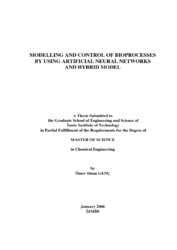Please use this identifier to cite or link to this item:
https://hdl.handle.net/11147/3244Full metadata record
| DC Field | Value | Language |
|---|---|---|
| dc.contributor.advisor | Batıgün, Ayşegül | - |
| dc.contributor.author | Genç, Ömer Sinan | - |
| dc.date.accessioned | 2014-07-22T13:51:10Z | - |
| dc.date.available | 2014-07-22T13:51:10Z | - |
| dc.date.issued | 2006 | - |
| dc.identifier.uri | http://hdl.handle.net/11147/3244 | - |
| dc.description | Thesis (Master)--Izmir Institute of Technology, Chemical Engineering, Izmir, 2006 | en_US |
| dc.description | Includes bibliographical references (leaves: 83-85) | en_US |
| dc.description | Text in English; Abstract: Turkish and English | en_US |
| dc.description | xi, 93 leaves | en_US |
| dc.description.abstract | The aim of this study is modeling and control of bioprocesses by using neural networks and hybrid model techniques. To investigate the modeling techniques, ethanol fermentation with Saccharomyces Cerevisiae and recombinant Zymomonas mobilis and finally gluconic acid fermentation with Pseudomonas ovalis processes are chosen.Model equations of these applications are obtained from literature. Numeric solutions are done in Matlab by using ODE solver. For neural network modeling a part of the numerical data is used for training of the network.In hybrid modeling technique, model equations which are obtained from literature are first linearized then to constitute the hybrid model linearized solution results are subtracted from numerical results and obtained values are taken as nonlinear part of the process. This nonlinear part is then solved by neural networks and the results of the neural networks are summed with the linearized solution results. This summation results constitute the hybrid model of the process. Hybrid and neural network models are compared. In some of the applications hybrid model gives slightly better results than the neural network model. But in all of the applications, required training time is much more less for hybrid model techniques. Also, it is observed that hybrid model obeys the physical constraints but neural network model solutions sometimes give meaningless outputs.In control application, a method is demonstrated for optimization of a bioprocess by using hybrid model with neural network structure. To demonstrate the optimization technique, a well known fermentation process is chosen from the literature. | en_US |
| dc.language.iso | en | en_US |
| dc.publisher | Izmir Institute of Technology | en_US |
| dc.rights | info:eu-repo/semantics/openAccess | en_US |
| dc.subject.lcsh | Bioreactors--Programmed instruction | en |
| dc.subject.lcsh | Neural networks (Computer science) | en |
| dc.title | Modelling and Control of Bioprocesses by Using Artificial Neural Networks and Hybridmodel | en_US |
| dc.type | Master Thesis | en_US |
| dc.institutionauthor | Genç, Ömer Sinan | - |
| dc.department | Thesis (Master)--İzmir Institute of Technology, Chemical Engineering | en_US |
| dc.relation.publicationcategory | Tez | en_US |
| dc.identifier.wosquality | N/A | - |
| dc.identifier.scopusquality | N/A | - |
| item.openairecristype | http://purl.org/coar/resource_type/c_18cf | - |
| item.languageiso639-1 | en | - |
| item.openairetype | Master Thesis | - |
| item.grantfulltext | open | - |
| item.fulltext | With Fulltext | - |
| item.cerifentitytype | Publications | - |
| Appears in Collections: | Master Degree / Yüksek Lisans Tezleri | |
Files in This Item:
| File | Description | Size | Format | |
|---|---|---|---|---|
| T000360.pdf | MasterThesis | 1.41 MB | Adobe PDF |  View/Open |
CORE Recommender
Page view(s)
184
checked on Mar 31, 2025
Download(s)
104
checked on Mar 31, 2025
Google ScholarTM
Check
Items in GCRIS Repository are protected by copyright, with all rights reserved, unless otherwise indicated.